This pipeline computes the correlation between cancer subtypes identified by different molecular patterns and selected clinical features.
Testing the association between subtypes identified by 12 different clustering approaches and 6 clinical features across 578 patients, 13 significant findings detected with P value < 0.05.
-
CNMF clustering analysis on array-based mRNA expression data identified 3 subtypes that correlate to 'Time to Death', 'AGE', and 'TUMOR.STAGE'.
-
Consensus hierarchical clustering analysis on array-based mRNA expression data identified 3 subtypes that correlate to 'AGE'.
-
CNMF clustering analysis on array-based miR expression data identified 3 subtypes that do not correlate to any clinical features.
-
Consensus hierarchical clustering analysis on array-based miR expression data identified 6 subtypes that correlate to 'AGE' and 'TUMOR.STAGE'.
-
3 subtypes identified in current cancer cohort by 'CN CNMF'. These subtypes correlate to 'AGE'.
-
3 subtypes identified in current cancer cohort by 'METHLYATION CNMF'. These subtypes correlate to 'AGE'.
-
CNMF clustering analysis on RPPA data identified 3 subtypes that correlate to 'Time to Death'.
-
Consensus hierarchical clustering analysis on RPPA data identified 4 subtypes that correlate to 'AGE'.
-
CNMF clustering analysis on sequencing-based mRNA expression data identified 3 subtypes that correlate to 'AGE'.
-
Consensus hierarchical clustering analysis on sequencing-based mRNA expression data identified 3 subtypes that correlate to 'AGE'.
-
CNMF clustering analysis on sequencing-based miR expression data identified 3 subtypes that correlate to 'Time to Death'.
-
Consensus hierarchical clustering analysis on sequencing-based miR expression data identified 3 subtypes that do not correlate to any clinical features.
Table 1. Get Full Table Overview of the association between subtypes identified by 12 different clustering approaches and 6 clinical features. Shown in the table are P values from statistical tests. Thresholded by P value < 0.05, 13 significant findings detected.
|
Clinical Features |
Time to Death |
AGE |
PRIMARY SITE OF DISEASE |
KARNOFSKY PERFORMANCE SCORE |
TUMOR STAGE |
RADIATIONS RADIATION REGIMENINDICATION |
| Statistical Tests | logrank test | ANOVA | Chi-square test | ANOVA | Chi-square test | Fisher's exact test |
| mRNA CNMF subtypes | 0.0275 | 0.0107 | 0.568 | 0.151 | 0.0364 | 0.793 |
| mRNA cHierClus subtypes | 0.802 | 0.00529 | 0.224 | 0.172 | 0.266 | 0.611 |
| miR CNMF subtypes | 0.0543 | 0.622 | 0.198 | 0.737 | 0.126 | 0.266 |
| miR cHierClus subtypes | 0.607 | 0.00948 | 0.837 | 0.0822 | 0.00314 | 0.525 |
| CN CNMF | 0.423 | 7.91e-09 | 0.288 | 0.544 | 0.131 | 0.395 |
| METHLYATION CNMF | 0.198 | 3.66e-10 | 0.387 | 0.637 | 0.29 | 1 |
| RPPA CNMF subtypes | 0.0056 | 0.58 | 0.885 | 0.61 | 0.333 | 0.129 |
| RPPA cHierClus subtypes | 0.174 | 0.0408 | 0.676 | 0.68 | 0.181 | 0.823 |
| RNAseq CNMF subtypes | 0.247 | 0.00506 | 1 | 0.104 | 0.589 | 1 |
| RNAseq cHierClus subtypes | 0.73 | 0.0371 | 0.592 | 0.104 | 0.456 | 0.675 |
| MIRseq CNMF subtypes | 0.0431 | 0.594 | 0.0583 | 0.207 | 0.193 | 0.476 |
| MIRseq cHierClus subtypes | 0.563 | 0.757 | 0.812 | 0.577 | 0.49 | 0.281 |
Table S1. Get Full Table Description of clustering approach #1: 'mRNA CNMF subtypes'
| Cluster Labels | 1 | 2 | 3 |
|---|---|---|---|
| Number of samples | 219 | 211 | 132 |
P value = 0.0275 (logrank test)
Table S2. Clustering Approach #1: 'mRNA CNMF subtypes' versus Clinical Feature #1: 'Time to Death'
| nPatients | nDeath | Duration Range (Median), Month | |
|---|---|---|---|
| ALL | 557 | 290 | 0.3 - 180.2 (28.3) |
| subtype1 | 216 | 125 | 0.3 - 152.0 (29.6) |
| subtype2 | 209 | 90 | 0.4 - 180.2 (27.0) |
| subtype3 | 132 | 75 | 0.3 - 119.1 (26.7) |
Figure S1. Get High-res Image Clustering Approach #1: 'mRNA CNMF subtypes' versus Clinical Feature #1: 'Time to Death'

P value = 0.0107 (ANOVA)
Table S3. Clustering Approach #1: 'mRNA CNMF subtypes' versus Clinical Feature #2: 'AGE'
| nPatients | Mean (Std.Dev) | |
|---|---|---|
| ALL | 551 | 59.7 (11.6) |
| subtype1 | 213 | 61.4 (11.5) |
| subtype2 | 207 | 58.0 (11.4) |
| subtype3 | 131 | 59.7 (11.8) |
Figure S2. Get High-res Image Clustering Approach #1: 'mRNA CNMF subtypes' versus Clinical Feature #2: 'AGE'

P value = 0.568 (Chi-square test)
Table S4. Clustering Approach #1: 'mRNA CNMF subtypes' versus Clinical Feature #3: 'PRIMARY.SITE.OF.DISEASE'
| nPatients | OMENTUM | OVARY | PERITONEUM (OVARY) |
|---|---|---|---|
| ALL | 2 | 558 | 2 |
| subtype1 | 0 | 219 | 0 |
| subtype2 | 1 | 209 | 1 |
| subtype3 | 1 | 130 | 1 |
Figure S3. Get High-res Image Clustering Approach #1: 'mRNA CNMF subtypes' versus Clinical Feature #3: 'PRIMARY.SITE.OF.DISEASE'

P value = 0.151 (ANOVA)
Table S5. Clustering Approach #1: 'mRNA CNMF subtypes' versus Clinical Feature #4: 'KARNOFSKY.PERFORMANCE.SCORE'
| nPatients | Mean (Std.Dev) | |
|---|---|---|
| ALL | 78 | 75.6 (12.8) |
| subtype1 | 30 | 78.0 (13.2) |
| subtype2 | 28 | 76.4 (12.2) |
| subtype3 | 20 | 71.0 (12.1) |
Figure S4. Get High-res Image Clustering Approach #1: 'mRNA CNMF subtypes' versus Clinical Feature #4: 'KARNOFSKY.PERFORMANCE.SCORE'

P value = 0.0364 (Chi-square test)
Table S6. Clustering Approach #1: 'mRNA CNMF subtypes' versus Clinical Feature #5: 'TUMOR.STAGE'
| nPatients | I | II | III | IV |
|---|---|---|---|---|
| ALL | 16 | 26 | 431 | 85 |
| subtype1 | 7 | 9 | 173 | 28 |
| subtype2 | 9 | 15 | 153 | 33 |
| subtype3 | 0 | 2 | 105 | 24 |
Figure S5. Get High-res Image Clustering Approach #1: 'mRNA CNMF subtypes' versus Clinical Feature #5: 'TUMOR.STAGE'

P value = 0.793 (Fisher's exact test)
Table S7. Clustering Approach #1: 'mRNA CNMF subtypes' versus Clinical Feature #6: 'RADIATIONS.RADIATION.REGIMENINDICATION'
| nPatients | NO | YES |
|---|---|---|
| ALL | 3 | 559 |
| subtype1 | 2 | 217 |
| subtype2 | 1 | 210 |
| subtype3 | 0 | 132 |
Figure S6. Get High-res Image Clustering Approach #1: 'mRNA CNMF subtypes' versus Clinical Feature #6: 'RADIATIONS.RADIATION.REGIMENINDICATION'

Table S8. Get Full Table Description of clustering approach #2: 'mRNA cHierClus subtypes'
| Cluster Labels | 1 | 2 | 3 |
|---|---|---|---|
| Number of samples | 233 | 202 | 127 |
P value = 0.802 (logrank test)
Table S9. Clustering Approach #2: 'mRNA cHierClus subtypes' versus Clinical Feature #1: 'Time to Death'
| nPatients | nDeath | Duration Range (Median), Month | |
|---|---|---|---|
| ALL | 557 | 290 | 0.3 - 180.2 (28.3) |
| subtype1 | 232 | 111 | 0.3 - 119.1 (24.2) |
| subtype2 | 199 | 113 | 0.3 - 152.0 (30.0) |
| subtype3 | 126 | 66 | 0.3 - 180.2 (31.5) |
Figure S7. Get High-res Image Clustering Approach #2: 'mRNA cHierClus subtypes' versus Clinical Feature #1: 'Time to Death'

P value = 0.00529 (ANOVA)
Table S10. Clustering Approach #2: 'mRNA cHierClus subtypes' versus Clinical Feature #2: 'AGE'
| nPatients | Mean (Std.Dev) | |
|---|---|---|
| ALL | 551 | 59.7 (11.6) |
| subtype1 | 231 | 58.5 (11.6) |
| subtype2 | 195 | 61.9 (11.8) |
| subtype3 | 125 | 58.7 (11.0) |
Figure S8. Get High-res Image Clustering Approach #2: 'mRNA cHierClus subtypes' versus Clinical Feature #2: 'AGE'

P value = 0.224 (Chi-square test)
Table S11. Clustering Approach #2: 'mRNA cHierClus subtypes' versus Clinical Feature #3: 'PRIMARY.SITE.OF.DISEASE'
| nPatients | OMENTUM | OVARY | PERITONEUM (OVARY) |
|---|---|---|---|
| ALL | 2 | 558 | 2 |
| subtype1 | 2 | 229 | 2 |
| subtype2 | 0 | 202 | 0 |
| subtype3 | 0 | 127 | 0 |
Figure S9. Get High-res Image Clustering Approach #2: 'mRNA cHierClus subtypes' versus Clinical Feature #3: 'PRIMARY.SITE.OF.DISEASE'

P value = 0.172 (ANOVA)
Table S12. Clustering Approach #2: 'mRNA cHierClus subtypes' versus Clinical Feature #4: 'KARNOFSKY.PERFORMANCE.SCORE'
| nPatients | Mean (Std.Dev) | |
|---|---|---|
| ALL | 78 | 75.6 (12.8) |
| subtype1 | 29 | 73.1 (12.3) |
| subtype2 | 20 | 80.0 (14.5) |
| subtype3 | 29 | 75.2 (11.5) |
Figure S10. Get High-res Image Clustering Approach #2: 'mRNA cHierClus subtypes' versus Clinical Feature #4: 'KARNOFSKY.PERFORMANCE.SCORE'

P value = 0.266 (Chi-square test)
Table S13. Clustering Approach #2: 'mRNA cHierClus subtypes' versus Clinical Feature #5: 'TUMOR.STAGE'
| nPatients | I | II | III | IV |
|---|---|---|---|---|
| ALL | 16 | 26 | 431 | 85 |
| subtype1 | 4 | 13 | 179 | 36 |
| subtype2 | 7 | 9 | 160 | 23 |
| subtype3 | 5 | 4 | 92 | 26 |
Figure S11. Get High-res Image Clustering Approach #2: 'mRNA cHierClus subtypes' versus Clinical Feature #5: 'TUMOR.STAGE'

P value = 0.611 (Fisher's exact test)
Table S14. Clustering Approach #2: 'mRNA cHierClus subtypes' versus Clinical Feature #6: 'RADIATIONS.RADIATION.REGIMENINDICATION'
| nPatients | NO | YES |
|---|---|---|
| ALL | 3 | 559 |
| subtype1 | 1 | 232 |
| subtype2 | 2 | 200 |
| subtype3 | 0 | 127 |
Figure S12. Get High-res Image Clustering Approach #2: 'mRNA cHierClus subtypes' versus Clinical Feature #6: 'RADIATIONS.RADIATION.REGIMENINDICATION'

Table S15. Get Full Table Description of clustering approach #3: 'miR CNMF subtypes'
| Cluster Labels | 1 | 2 | 3 |
|---|---|---|---|
| Number of samples | 157 | 165 | 238 |
P value = 0.0543 (logrank test)
Table S16. Clustering Approach #3: 'miR CNMF subtypes' versus Clinical Feature #1: 'Time to Death'
| nPatients | nDeath | Duration Range (Median), Month | |
|---|---|---|---|
| ALL | 555 | 290 | 0.3 - 180.2 (28.2) |
| subtype1 | 156 | 86 | 0.3 - 130.0 (26.4) |
| subtype2 | 162 | 91 | 0.3 - 115.9 (24.7) |
| subtype3 | 237 | 113 | 0.3 - 180.2 (30.1) |
Figure S13. Get High-res Image Clustering Approach #3: 'miR CNMF subtypes' versus Clinical Feature #1: 'Time to Death'

P value = 0.622 (ANOVA)
Table S17. Clustering Approach #3: 'miR CNMF subtypes' versus Clinical Feature #2: 'AGE'
| nPatients | Mean (Std.Dev) | |
|---|---|---|
| ALL | 549 | 59.7 (11.6) |
| subtype1 | 153 | 59.3 (12.5) |
| subtype2 | 162 | 59.3 (11.6) |
| subtype3 | 234 | 60.3 (11.1) |
Figure S14. Get High-res Image Clustering Approach #3: 'miR CNMF subtypes' versus Clinical Feature #2: 'AGE'

P value = 0.198 (Chi-square test)
Table S18. Clustering Approach #3: 'miR CNMF subtypes' versus Clinical Feature #3: 'PRIMARY.SITE.OF.DISEASE'
| nPatients | OMENTUM | OVARY | PERITONEUM (OVARY) |
|---|---|---|---|
| ALL | 2 | 556 | 2 |
| subtype1 | 0 | 155 | 2 |
| subtype2 | 1 | 164 | 0 |
| subtype3 | 1 | 237 | 0 |
Figure S15. Get High-res Image Clustering Approach #3: 'miR CNMF subtypes' versus Clinical Feature #3: 'PRIMARY.SITE.OF.DISEASE'

P value = 0.737 (ANOVA)
Table S19. Clustering Approach #3: 'miR CNMF subtypes' versus Clinical Feature #4: 'KARNOFSKY.PERFORMANCE.SCORE'
| nPatients | Mean (Std.Dev) | |
|---|---|---|
| ALL | 78 | 75.6 (12.8) |
| subtype1 | 24 | 76.7 (12.7) |
| subtype2 | 23 | 73.9 (15.3) |
| subtype3 | 31 | 76.1 (10.9) |
Figure S16. Get High-res Image Clustering Approach #3: 'miR CNMF subtypes' versus Clinical Feature #4: 'KARNOFSKY.PERFORMANCE.SCORE'

P value = 0.126 (Chi-square test)
Table S20. Clustering Approach #3: 'miR CNMF subtypes' versus Clinical Feature #5: 'TUMOR.STAGE'
| nPatients | I | II | III | IV |
|---|---|---|---|---|
| ALL | 16 | 25 | 430 | 85 |
| subtype1 | 3 | 6 | 114 | 32 |
| subtype2 | 7 | 5 | 135 | 17 |
| subtype3 | 6 | 14 | 181 | 36 |
Figure S17. Get High-res Image Clustering Approach #3: 'miR CNMF subtypes' versus Clinical Feature #5: 'TUMOR.STAGE'

P value = 0.266 (Fisher's exact test)
Table S21. Clustering Approach #3: 'miR CNMF subtypes' versus Clinical Feature #6: 'RADIATIONS.RADIATION.REGIMENINDICATION'
| nPatients | NO | YES |
|---|---|---|
| ALL | 3 | 557 |
| subtype1 | 0 | 157 |
| subtype2 | 0 | 165 |
| subtype3 | 3 | 235 |
Figure S18. Get High-res Image Clustering Approach #3: 'miR CNMF subtypes' versus Clinical Feature #6: 'RADIATIONS.RADIATION.REGIMENINDICATION'

Table S22. Get Full Table Description of clustering approach #4: 'miR cHierClus subtypes'
| Cluster Labels | 1 | 2 | 3 | 4 | 5 | 6 |
|---|---|---|---|---|---|---|
| Number of samples | 66 | 120 | 122 | 102 | 56 | 94 |
P value = 0.607 (logrank test)
Table S23. Clustering Approach #4: 'miR cHierClus subtypes' versus Clinical Feature #1: 'Time to Death'
| nPatients | nDeath | Duration Range (Median), Month | |
|---|---|---|---|
| ALL | 555 | 290 | 0.3 - 180.2 (28.2) |
| subtype1 | 65 | 31 | 0.8 - 115.9 (26.9) |
| subtype2 | 119 | 65 | 1.0 - 180.2 (28.7) |
| subtype3 | 122 | 65 | 0.3 - 130.0 (25.5) |
| subtype4 | 102 | 46 | 0.3 - 125.7 (29.6) |
| subtype5 | 54 | 31 | 1.8 - 106.0 (22.4) |
| subtype6 | 93 | 52 | 0.5 - 152.0 (30.4) |
Figure S19. Get High-res Image Clustering Approach #4: 'miR cHierClus subtypes' versus Clinical Feature #1: 'Time to Death'

P value = 0.00948 (ANOVA)
Table S24. Clustering Approach #4: 'miR cHierClus subtypes' versus Clinical Feature #2: 'AGE'
| nPatients | Mean (Std.Dev) | |
|---|---|---|
| ALL | 549 | 59.7 (11.6) |
| subtype1 | 66 | 56.5 (11.2) |
| subtype2 | 119 | 57.9 (11.2) |
| subtype3 | 118 | 59.9 (12.3) |
| subtype4 | 100 | 60.1 (10.8) |
| subtype5 | 56 | 62.2 (13.2) |
| subtype6 | 90 | 62.2 (10.6) |
Figure S20. Get High-res Image Clustering Approach #4: 'miR cHierClus subtypes' versus Clinical Feature #2: 'AGE'

P value = 0.837 (Chi-square test)
Table S25. Clustering Approach #4: 'miR cHierClus subtypes' versus Clinical Feature #3: 'PRIMARY.SITE.OF.DISEASE'
| nPatients | OMENTUM | OVARY | PERITONEUM (OVARY) |
|---|---|---|---|
| ALL | 2 | 556 | 2 |
| subtype1 | 0 | 66 | 0 |
| subtype2 | 1 | 118 | 1 |
| subtype3 | 0 | 121 | 1 |
| subtype4 | 1 | 101 | 0 |
| subtype5 | 0 | 56 | 0 |
| subtype6 | 0 | 94 | 0 |
Figure S21. Get High-res Image Clustering Approach #4: 'miR cHierClus subtypes' versus Clinical Feature #3: 'PRIMARY.SITE.OF.DISEASE'

P value = 0.0822 (ANOVA)
Table S26. Clustering Approach #4: 'miR cHierClus subtypes' versus Clinical Feature #4: 'KARNOFSKY.PERFORMANCE.SCORE'
| nPatients | Mean (Std.Dev) | |
|---|---|---|
| ALL | 78 | 75.6 (12.8) |
| subtype1 | 9 | 75.6 (13.3) |
| subtype2 | 19 | 75.8 (12.6) |
| subtype3 | 17 | 76.5 (14.6) |
| subtype4 | 17 | 76.5 (10.6) |
| subtype5 | 5 | 88.0 (11.0) |
| subtype6 | 11 | 67.3 (10.1) |
Figure S22. Get High-res Image Clustering Approach #4: 'miR cHierClus subtypes' versus Clinical Feature #4: 'KARNOFSKY.PERFORMANCE.SCORE'

P value = 0.00314 (Chi-square test)
Table S27. Clustering Approach #4: 'miR cHierClus subtypes' versus Clinical Feature #5: 'TUMOR.STAGE'
| nPatients | I | II | III | IV |
|---|---|---|---|---|
| ALL | 16 | 25 | 430 | 85 |
| subtype1 | 5 | 1 | 48 | 12 |
| subtype2 | 0 | 0 | 98 | 21 |
| subtype3 | 2 | 7 | 91 | 21 |
| subtype4 | 5 | 7 | 73 | 17 |
| subtype5 | 1 | 3 | 40 | 11 |
| subtype6 | 3 | 7 | 80 | 3 |
Figure S23. Get High-res Image Clustering Approach #4: 'miR cHierClus subtypes' versus Clinical Feature #5: 'TUMOR.STAGE'

P value = 0.525 (Chi-square test)
Table S28. Clustering Approach #4: 'miR cHierClus subtypes' versus Clinical Feature #6: 'RADIATIONS.RADIATION.REGIMENINDICATION'
| nPatients | NO | YES |
|---|---|---|
| ALL | 3 | 557 |
| subtype1 | 0 | 66 |
| subtype2 | 0 | 120 |
| subtype3 | 0 | 122 |
| subtype4 | 1 | 101 |
| subtype5 | 1 | 55 |
| subtype6 | 1 | 93 |
Figure S24. Get High-res Image Clustering Approach #4: 'miR cHierClus subtypes' versus Clinical Feature #6: 'RADIATIONS.RADIATION.REGIMENINDICATION'

Table S29. Get Full Table Description of clustering approach #5: 'CN CNMF'
| Cluster Labels | 1 | 2 | 3 |
|---|---|---|---|
| Number of samples | 162 | 204 | 186 |
P value = 0.423 (logrank test)
Table S30. Clustering Approach #5: 'CN CNMF' versus Clinical Feature #1: 'Time to Death'
| nPatients | nDeath | Duration Range (Median), Month | |
|---|---|---|---|
| ALL | 546 | 283 | 0.3 - 180.2 (28.3) |
| subtype1 | 160 | 90 | 0.8 - 119.1 (29.3) |
| subtype2 | 202 | 98 | 0.3 - 130.0 (30.0) |
| subtype3 | 184 | 95 | 0.3 - 180.2 (22.3) |
Figure S25. Get High-res Image Clustering Approach #5: 'CN CNMF' versus Clinical Feature #1: 'Time to Death'

P value = 7.91e-09 (ANOVA)
Table S31. Clustering Approach #5: 'CN CNMF' versus Clinical Feature #2: 'AGE'
| nPatients | Mean (Std.Dev) | |
|---|---|---|
| ALL | 541 | 59.8 (11.6) |
| subtype1 | 158 | 59.5 (12.4) |
| subtype2 | 203 | 56.6 (10.9) |
| subtype3 | 180 | 63.7 (10.5) |
Figure S26. Get High-res Image Clustering Approach #5: 'CN CNMF' versus Clinical Feature #2: 'AGE'

P value = 0.288 (Chi-square test)
Table S32. Clustering Approach #5: 'CN CNMF' versus Clinical Feature #3: 'PRIMARY.SITE.OF.DISEASE'
| nPatients | OMENTUM | OVARY | PERITONEUM (OVARY) |
|---|---|---|---|
| ALL | 2 | 548 | 2 |
| subtype1 | 1 | 161 | 0 |
| subtype2 | 1 | 203 | 0 |
| subtype3 | 0 | 184 | 2 |
Figure S27. Get High-res Image Clustering Approach #5: 'CN CNMF' versus Clinical Feature #3: 'PRIMARY.SITE.OF.DISEASE'

P value = 0.544 (ANOVA)
Table S33. Clustering Approach #5: 'CN CNMF' versus Clinical Feature #4: 'KARNOFSKY.PERFORMANCE.SCORE'
| nPatients | Mean (Std.Dev) | |
|---|---|---|
| ALL | 76 | 75.5 (12.9) |
| subtype1 | 18 | 76.7 (10.3) |
| subtype2 | 31 | 73.5 (13.1) |
| subtype3 | 27 | 77.0 (14.4) |
Figure S28. Get High-res Image Clustering Approach #5: 'CN CNMF' versus Clinical Feature #4: 'KARNOFSKY.PERFORMANCE.SCORE'

P value = 0.131 (Chi-square test)
Table S34. Clustering Approach #5: 'CN CNMF' versus Clinical Feature #5: 'TUMOR.STAGE'
| nPatients | I | II | III | IV |
|---|---|---|---|---|
| ALL | 16 | 26 | 423 | 82 |
| subtype1 | 7 | 7 | 123 | 23 |
| subtype2 | 4 | 10 | 149 | 41 |
| subtype3 | 5 | 9 | 151 | 18 |
Figure S29. Get High-res Image Clustering Approach #5: 'CN CNMF' versus Clinical Feature #5: 'TUMOR.STAGE'

P value = 0.395 (Fisher's exact test)
Table S35. Clustering Approach #5: 'CN CNMF' versus Clinical Feature #6: 'RADIATIONS.RADIATION.REGIMENINDICATION'
| nPatients | NO | YES |
|---|---|---|
| ALL | 3 | 549 |
| subtype1 | 1 | 161 |
| subtype2 | 0 | 204 |
| subtype3 | 2 | 184 |
Figure S30. Get High-res Image Clustering Approach #5: 'CN CNMF' versus Clinical Feature #6: 'RADIATIONS.RADIATION.REGIMENINDICATION'

Table S36. Get Full Table Description of clustering approach #6: 'METHLYATION CNMF'
| Cluster Labels | 1 | 2 | 3 |
|---|---|---|---|
| Number of samples | 174 | 181 | 219 |
P value = 0.198 (logrank test)
Table S37. Clustering Approach #6: 'METHLYATION CNMF' versus Clinical Feature #1: 'Time to Death'
| nPatients | nDeath | Duration Range (Median), Month | |
|---|---|---|---|
| ALL | 557 | 291 | 0.3 - 180.2 (28.3) |
| subtype1 | 168 | 100 | 0.3 - 152.0 (26.9) |
| subtype2 | 173 | 86 | 0.8 - 180.2 (28.6) |
| subtype3 | 216 | 105 | 0.3 - 130.0 (28.7) |
Figure S31. Get High-res Image Clustering Approach #6: 'METHLYATION CNMF' versus Clinical Feature #1: 'Time to Death'

P value = 3.66e-10 (ANOVA)
Table S38. Clustering Approach #6: 'METHLYATION CNMF' versus Clinical Feature #2: 'AGE'
| nPatients | Mean (Std.Dev) | |
|---|---|---|
| ALL | 553 | 59.8 (11.6) |
| subtype1 | 167 | 64.6 (10.6) |
| subtype2 | 171 | 57.6 (12.0) |
| subtype3 | 215 | 57.8 (10.9) |
Figure S32. Get High-res Image Clustering Approach #6: 'METHLYATION CNMF' versus Clinical Feature #2: 'AGE'

P value = 0.387 (Chi-square test)
Table S39. Clustering Approach #6: 'METHLYATION CNMF' versus Clinical Feature #3: 'PRIMARY.SITE.OF.DISEASE'
| nPatients | OMENTUM | OVARY | PERITONEUM (OVARY) |
|---|---|---|---|
| ALL | 2 | 560 | 2 |
| subtype1 | 0 | 169 | 1 |
| subtype2 | 0 | 176 | 0 |
| subtype3 | 2 | 215 | 1 |
Figure S33. Get High-res Image Clustering Approach #6: 'METHLYATION CNMF' versus Clinical Feature #3: 'PRIMARY.SITE.OF.DISEASE'

P value = 0.637 (ANOVA)
Table S40. Clustering Approach #6: 'METHLYATION CNMF' versus Clinical Feature #4: 'KARNOFSKY.PERFORMANCE.SCORE'
| nPatients | Mean (Std.Dev) | |
|---|---|---|
| ALL | 78 | 75.6 (12.8) |
| subtype1 | 23 | 74.8 (13.8) |
| subtype2 | 20 | 74.0 (13.1) |
| subtype3 | 35 | 77.1 (12.0) |
Figure S34. Get High-res Image Clustering Approach #6: 'METHLYATION CNMF' versus Clinical Feature #4: 'KARNOFSKY.PERFORMANCE.SCORE'

P value = 0.29 (Chi-square test)
Table S41. Clustering Approach #6: 'METHLYATION CNMF' versus Clinical Feature #5: 'TUMOR.STAGE'
| nPatients | I | II | III | IV |
|---|---|---|---|---|
| ALL | 16 | 26 | 430 | 86 |
| subtype1 | 4 | 7 | 135 | 21 |
| subtype2 | 3 | 5 | 134 | 32 |
| subtype3 | 9 | 14 | 161 | 33 |
Figure S35. Get High-res Image Clustering Approach #6: 'METHLYATION CNMF' versus Clinical Feature #5: 'TUMOR.STAGE'

P value = 1 (Fisher's exact test)
Table S42. Clustering Approach #6: 'METHLYATION CNMF' versus Clinical Feature #6: 'RADIATIONS.RADIATION.REGIMENINDICATION'
| nPatients | NO | YES |
|---|---|---|
| ALL | 3 | 571 |
| subtype1 | 1 | 173 |
| subtype2 | 1 | 180 |
| subtype3 | 1 | 218 |
Figure S36. Get High-res Image Clustering Approach #6: 'METHLYATION CNMF' versus Clinical Feature #6: 'RADIATIONS.RADIATION.REGIMENINDICATION'

Table S43. Get Full Table Description of clustering approach #7: 'RPPA CNMF subtypes'
| Cluster Labels | 1 | 2 | 3 |
|---|---|---|---|
| Number of samples | 128 | 207 | 72 |
P value = 0.0056 (logrank test)
Table S44. Clustering Approach #7: 'RPPA CNMF subtypes' versus Clinical Feature #1: 'Time to Death'
| nPatients | nDeath | Duration Range (Median), Month | |
|---|---|---|---|
| ALL | 400 | 209 | 0.3 - 180.2 (28.6) |
| subtype1 | 125 | 71 | 0.4 - 125.7 (31.1) |
| subtype2 | 204 | 92 | 0.3 - 180.2 (25.2) |
| subtype3 | 71 | 46 | 0.5 - 89.3 (25.9) |
Figure S37. Get High-res Image Clustering Approach #7: 'RPPA CNMF subtypes' versus Clinical Feature #1: 'Time to Death'

P value = 0.58 (ANOVA)
Table S45. Clustering Approach #7: 'RPPA CNMF subtypes' versus Clinical Feature #2: 'AGE'
| nPatients | Mean (Std.Dev) | |
|---|---|---|
| ALL | 400 | 59.7 (11.8) |
| subtype1 | 126 | 60.0 (12.3) |
| subtype2 | 204 | 59.1 (11.7) |
| subtype3 | 70 | 60.7 (11.3) |
Figure S38. Get High-res Image Clustering Approach #7: 'RPPA CNMF subtypes' versus Clinical Feature #2: 'AGE'

P value = 0.885 (Chi-square test)
Table S46. Clustering Approach #7: 'RPPA CNMF subtypes' versus Clinical Feature #3: 'PRIMARY.SITE.OF.DISEASE'
| nPatients | OMENTUM | OVARY | PERITONEUM (OVARY) |
|---|---|---|---|
| ALL | 2 | 403 | 2 |
| subtype1 | 1 | 126 | 1 |
| subtype2 | 1 | 205 | 1 |
| subtype3 | 0 | 72 | 0 |
Figure S39. Get High-res Image Clustering Approach #7: 'RPPA CNMF subtypes' versus Clinical Feature #3: 'PRIMARY.SITE.OF.DISEASE'

P value = 0.61 (ANOVA)
Table S47. Clustering Approach #7: 'RPPA CNMF subtypes' versus Clinical Feature #4: 'KARNOFSKY.PERFORMANCE.SCORE'
| nPatients | Mean (Std.Dev) | |
|---|---|---|
| ALL | 51 | 74.9 (11.9) |
| subtype1 | 19 | 76.8 (10.0) |
| subtype2 | 27 | 73.3 (13.6) |
| subtype3 | 5 | 76.0 (8.9) |
Figure S40. Get High-res Image Clustering Approach #7: 'RPPA CNMF subtypes' versus Clinical Feature #4: 'KARNOFSKY.PERFORMANCE.SCORE'

P value = 0.333 (Chi-square test)
Table S48. Clustering Approach #7: 'RPPA CNMF subtypes' versus Clinical Feature #5: 'TUMOR.STAGE'
| nPatients | I | II | III | IV |
|---|---|---|---|---|
| ALL | 14 | 19 | 317 | 52 |
| subtype1 | 4 | 7 | 96 | 20 |
| subtype2 | 9 | 11 | 164 | 20 |
| subtype3 | 1 | 1 | 57 | 12 |
Figure S41. Get High-res Image Clustering Approach #7: 'RPPA CNMF subtypes' versus Clinical Feature #5: 'TUMOR.STAGE'

P value = 0.129 (Fisher's exact test)
Table S49. Clustering Approach #7: 'RPPA CNMF subtypes' versus Clinical Feature #6: 'RADIATIONS.RADIATION.REGIMENINDICATION'
| nPatients | NO | YES |
|---|---|---|
| ALL | 2 | 405 |
| subtype1 | 2 | 126 |
| subtype2 | 0 | 207 |
| subtype3 | 0 | 72 |
Figure S42. Get High-res Image Clustering Approach #7: 'RPPA CNMF subtypes' versus Clinical Feature #6: 'RADIATIONS.RADIATION.REGIMENINDICATION'

Table S50. Get Full Table Description of clustering approach #8: 'RPPA cHierClus subtypes'
| Cluster Labels | 1 | 2 | 3 | 4 |
|---|---|---|---|---|
| Number of samples | 101 | 68 | 145 | 93 |
P value = 0.174 (logrank test)
Table S51. Clustering Approach #8: 'RPPA cHierClus subtypes' versus Clinical Feature #1: 'Time to Death'
| nPatients | nDeath | Duration Range (Median), Month | |
|---|---|---|---|
| ALL | 400 | 209 | 0.3 - 180.2 (28.6) |
| subtype1 | 97 | 45 | 0.3 - 115.9 (28.5) |
| subtype2 | 68 | 42 | 0.8 - 180.2 (35.5) |
| subtype3 | 143 | 84 | 0.4 - 125.7 (27.5) |
| subtype4 | 92 | 38 | 0.5 - 152.0 (22.6) |
Figure S43. Get High-res Image Clustering Approach #8: 'RPPA cHierClus subtypes' versus Clinical Feature #1: 'Time to Death'

P value = 0.0408 (ANOVA)
Table S52. Clustering Approach #8: 'RPPA cHierClus subtypes' versus Clinical Feature #2: 'AGE'
| nPatients | Mean (Std.Dev) | |
|---|---|---|
| ALL | 400 | 59.7 (11.8) |
| subtype1 | 100 | 57.7 (11.8) |
| subtype2 | 67 | 61.5 (11.1) |
| subtype3 | 142 | 61.2 (12.1) |
| subtype4 | 91 | 58.2 (11.6) |
Figure S44. Get High-res Image Clustering Approach #8: 'RPPA cHierClus subtypes' versus Clinical Feature #2: 'AGE'

P value = 0.676 (Chi-square test)
Table S53. Clustering Approach #8: 'RPPA cHierClus subtypes' versus Clinical Feature #3: 'PRIMARY.SITE.OF.DISEASE'
| nPatients | OMENTUM | OVARY | PERITONEUM (OVARY) |
|---|---|---|---|
| ALL | 2 | 403 | 2 |
| subtype1 | 0 | 101 | 0 |
| subtype2 | 1 | 67 | 0 |
| subtype3 | 1 | 143 | 1 |
| subtype4 | 0 | 92 | 1 |
Figure S45. Get High-res Image Clustering Approach #8: 'RPPA cHierClus subtypes' versus Clinical Feature #3: 'PRIMARY.SITE.OF.DISEASE'

P value = 0.68 (ANOVA)
Table S54. Clustering Approach #8: 'RPPA cHierClus subtypes' versus Clinical Feature #4: 'KARNOFSKY.PERFORMANCE.SCORE'
| nPatients | Mean (Std.Dev) | |
|---|---|---|
| ALL | 51 | 74.9 (11.9) |
| subtype1 | 5 | 80.0 (0.0) |
| subtype2 | 9 | 75.6 (16.7) |
| subtype3 | 13 | 72.3 (10.1) |
| subtype4 | 24 | 75.0 (12.2) |
Figure S46. Get High-res Image Clustering Approach #8: 'RPPA cHierClus subtypes' versus Clinical Feature #4: 'KARNOFSKY.PERFORMANCE.SCORE'

P value = 0.181 (Chi-square test)
Table S55. Clustering Approach #8: 'RPPA cHierClus subtypes' versus Clinical Feature #5: 'TUMOR.STAGE'
| nPatients | I | II | III | IV |
|---|---|---|---|---|
| ALL | 14 | 19 | 317 | 52 |
| subtype1 | 8 | 5 | 76 | 9 |
| subtype2 | 2 | 4 | 53 | 9 |
| subtype3 | 3 | 5 | 111 | 24 |
| subtype4 | 1 | 5 | 77 | 10 |
Figure S47. Get High-res Image Clustering Approach #8: 'RPPA cHierClus subtypes' versus Clinical Feature #5: 'TUMOR.STAGE'

P value = 0.823 (Fisher's exact test)
Table S56. Clustering Approach #8: 'RPPA cHierClus subtypes' versus Clinical Feature #6: 'RADIATIONS.RADIATION.REGIMENINDICATION'
| nPatients | NO | YES |
|---|---|---|
| ALL | 2 | 405 |
| subtype1 | 0 | 101 |
| subtype2 | 0 | 68 |
| subtype3 | 1 | 144 |
| subtype4 | 1 | 92 |
Figure S48. Get High-res Image Clustering Approach #8: 'RPPA cHierClus subtypes' versus Clinical Feature #6: 'RADIATIONS.RADIATION.REGIMENINDICATION'

Table S57. Get Full Table Description of clustering approach #9: 'RNAseq CNMF subtypes'
| Cluster Labels | 1 | 2 | 3 |
|---|---|---|---|
| Number of samples | 100 | 70 | 92 |
P value = 0.247 (logrank test)
Table S58. Clustering Approach #9: 'RNAseq CNMF subtypes' versus Clinical Feature #1: 'Time to Death'
| nPatients | nDeath | Duration Range (Median), Month | |
|---|---|---|---|
| ALL | 260 | 147 | 0.3 - 180.2 (28.0) |
| subtype1 | 100 | 55 | 0.4 - 180.2 (27.7) |
| subtype2 | 69 | 37 | 1.0 - 116.1 (35.1) |
| subtype3 | 91 | 55 | 0.3 - 152.0 (25.0) |
Figure S49. Get High-res Image Clustering Approach #9: 'RNAseq CNMF subtypes' versus Clinical Feature #1: 'Time to Death'

P value = 0.00506 (ANOVA)
Table S59. Clustering Approach #9: 'RNAseq CNMF subtypes' versus Clinical Feature #2: 'AGE'
| nPatients | Mean (Std.Dev) | |
|---|---|---|
| ALL | 255 | 59.0 (10.8) |
| subtype1 | 98 | 59.7 (10.6) |
| subtype2 | 68 | 55.5 (10.9) |
| subtype3 | 89 | 60.9 (10.6) |
Figure S50. Get High-res Image Clustering Approach #9: 'RNAseq CNMF subtypes' versus Clinical Feature #2: 'AGE'

P value = 1 (Fisher's exact test)
Table S60. Clustering Approach #9: 'RNAseq CNMF subtypes' versus Clinical Feature #3: 'PRIMARY.SITE.OF.DISEASE'
| nPatients | OMENTUM | OVARY |
|---|---|---|
| ALL | 1 | 261 |
| subtype1 | 1 | 99 |
| subtype2 | 0 | 70 |
| subtype3 | 0 | 92 |
Figure S51. Get High-res Image Clustering Approach #9: 'RNAseq CNMF subtypes' versus Clinical Feature #3: 'PRIMARY.SITE.OF.DISEASE'
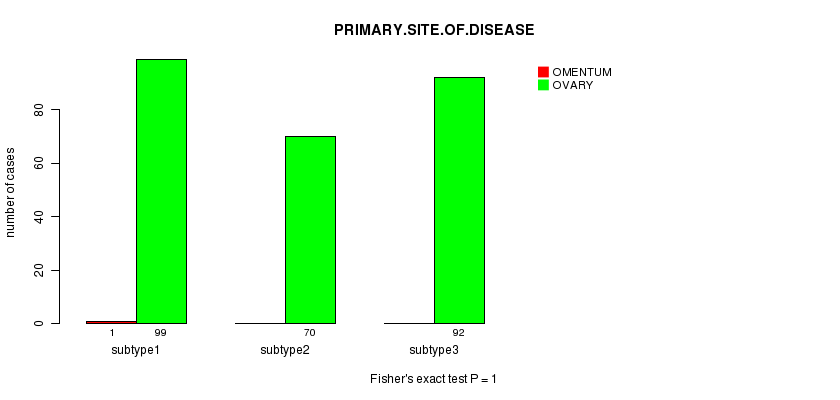
P value = 0.104 (ANOVA)
Table S61. Clustering Approach #9: 'RNAseq CNMF subtypes' versus Clinical Feature #4: 'KARNOFSKY.PERFORMANCE.SCORE'
| nPatients | Mean (Std.Dev) | |
|---|---|---|
| ALL | 14 | 74.3 (12.2) |
| subtype1 | 10 | 72.0 (14.0) |
| subtype2 | 1 | 80.0 (NA) |
| subtype3 | 3 | 80.0 (0.0) |
Figure S52. Get High-res Image Clustering Approach #9: 'RNAseq CNMF subtypes' versus Clinical Feature #4: 'KARNOFSKY.PERFORMANCE.SCORE'

P value = 0.589 (Chi-square test)
Table S62. Clustering Approach #9: 'RNAseq CNMF subtypes' versus Clinical Feature #5: 'TUMOR.STAGE'
| nPatients | II | III | IV |
|---|---|---|---|
| ALL | 18 | 210 | 33 |
| subtype1 | 7 | 79 | 14 |
| subtype2 | 6 | 53 | 11 |
| subtype3 | 5 | 78 | 8 |
Figure S53. Get High-res Image Clustering Approach #9: 'RNAseq CNMF subtypes' versus Clinical Feature #5: 'TUMOR.STAGE'

P value = 1 (Fisher's exact test)
Table S63. Clustering Approach #9: 'RNAseq CNMF subtypes' versus Clinical Feature #6: 'RADIATIONS.RADIATION.REGIMENINDICATION'
| nPatients | NO | YES |
|---|---|---|
| ALL | 2 | 260 |
| subtype1 | 1 | 99 |
| subtype2 | 0 | 70 |
| subtype3 | 1 | 91 |
Figure S54. Get High-res Image Clustering Approach #9: 'RNAseq CNMF subtypes' versus Clinical Feature #6: 'RADIATIONS.RADIATION.REGIMENINDICATION'
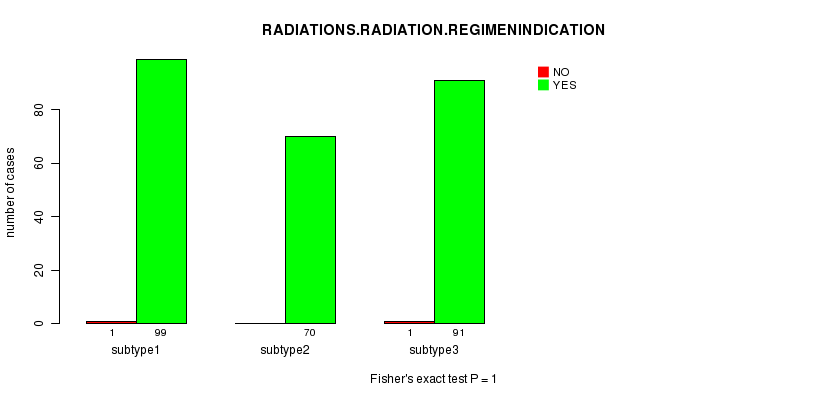
Table S64. Get Full Table Description of clustering approach #10: 'RNAseq cHierClus subtypes'
| Cluster Labels | 1 | 2 | 3 |
|---|---|---|---|
| Number of samples | 104 | 107 | 51 |
P value = 0.73 (logrank test)
Table S65. Clustering Approach #10: 'RNAseq cHierClus subtypes' versus Clinical Feature #1: 'Time to Death'
| nPatients | nDeath | Duration Range (Median), Month | |
|---|---|---|---|
| ALL | 260 | 147 | 0.3 - 180.2 (28.0) |
| subtype1 | 103 | 54 | 0.4 - 180.2 (27.9) |
| subtype2 | 107 | 65 | 0.4 - 152.0 (28.3) |
| subtype3 | 50 | 28 | 0.3 - 115.9 (27.8) |
Figure S55. Get High-res Image Clustering Approach #10: 'RNAseq cHierClus subtypes' versus Clinical Feature #1: 'Time to Death'

P value = 0.0371 (ANOVA)
Table S66. Clustering Approach #10: 'RNAseq cHierClus subtypes' versus Clinical Feature #2: 'AGE'
| nPatients | Mean (Std.Dev) | |
|---|---|---|
| ALL | 255 | 59.0 (10.8) |
| subtype1 | 101 | 58.8 (10.2) |
| subtype2 | 104 | 60.7 (11.3) |
| subtype3 | 50 | 56.0 (10.6) |
Figure S56. Get High-res Image Clustering Approach #10: 'RNAseq cHierClus subtypes' versus Clinical Feature #2: 'AGE'

P value = 0.592 (Fisher's exact test)
Table S67. Clustering Approach #10: 'RNAseq cHierClus subtypes' versus Clinical Feature #3: 'PRIMARY.SITE.OF.DISEASE'
| nPatients | OMENTUM | OVARY |
|---|---|---|
| ALL | 1 | 261 |
| subtype1 | 1 | 103 |
| subtype2 | 0 | 107 |
| subtype3 | 0 | 51 |
Figure S57. Get High-res Image Clustering Approach #10: 'RNAseq cHierClus subtypes' versus Clinical Feature #3: 'PRIMARY.SITE.OF.DISEASE'
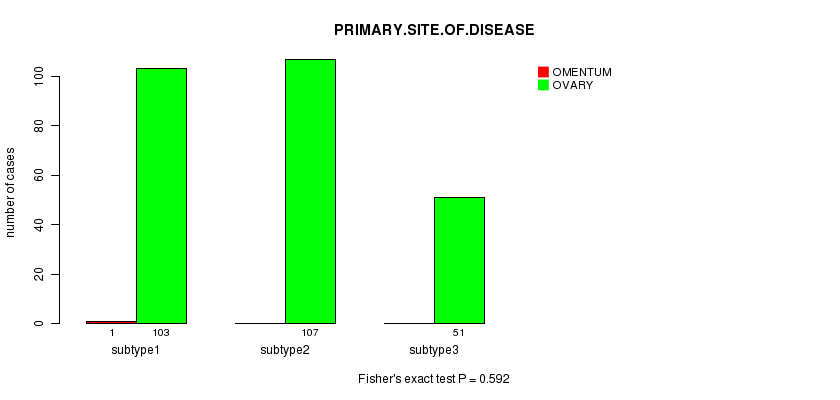
P value = 0.104 (ANOVA)
Table S68. Clustering Approach #10: 'RNAseq cHierClus subtypes' versus Clinical Feature #4: 'KARNOFSKY.PERFORMANCE.SCORE'
| nPatients | Mean (Std.Dev) | |
|---|---|---|
| ALL | 14 | 74.3 (12.2) |
| subtype1 | 11 | 72.7 (13.5) |
| subtype2 | 3 | 80.0 (0.0) |
Figure S58. Get High-res Image Clustering Approach #10: 'RNAseq cHierClus subtypes' versus Clinical Feature #4: 'KARNOFSKY.PERFORMANCE.SCORE'
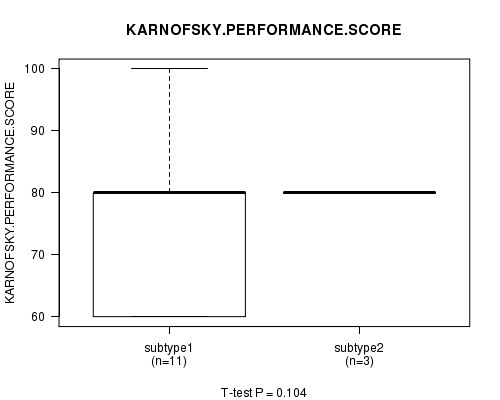
P value = 0.456 (Chi-square test)
Table S69. Clustering Approach #10: 'RNAseq cHierClus subtypes' versus Clinical Feature #5: 'TUMOR.STAGE'
| nPatients | II | III | IV |
|---|---|---|---|
| ALL | 18 | 210 | 33 |
| subtype1 | 6 | 85 | 13 |
| subtype2 | 8 | 88 | 10 |
| subtype3 | 4 | 37 | 10 |
Figure S59. Get High-res Image Clustering Approach #10: 'RNAseq cHierClus subtypes' versus Clinical Feature #5: 'TUMOR.STAGE'
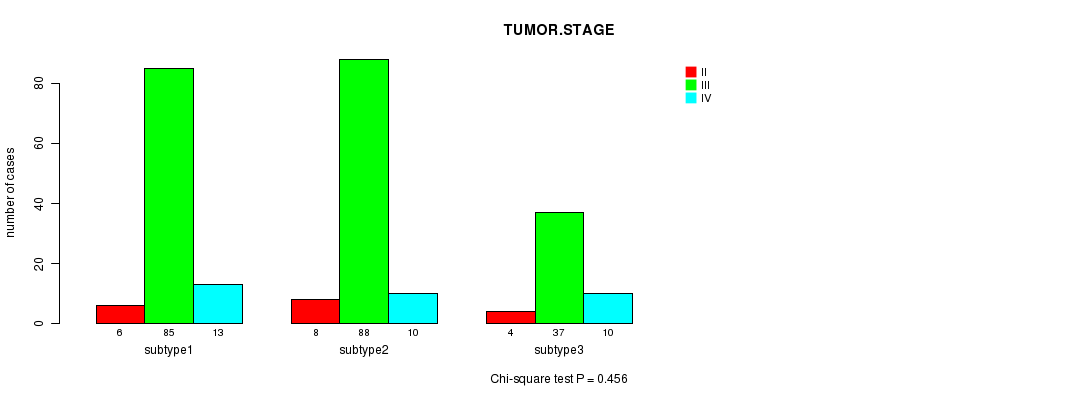
P value = 0.675 (Fisher's exact test)
Table S70. Clustering Approach #10: 'RNAseq cHierClus subtypes' versus Clinical Feature #6: 'RADIATIONS.RADIATION.REGIMENINDICATION'
| nPatients | NO | YES |
|---|---|---|
| ALL | 2 | 260 |
| subtype1 | 0 | 104 |
| subtype2 | 2 | 105 |
| subtype3 | 0 | 51 |
Figure S60. Get High-res Image Clustering Approach #10: 'RNAseq cHierClus subtypes' versus Clinical Feature #6: 'RADIATIONS.RADIATION.REGIMENINDICATION'
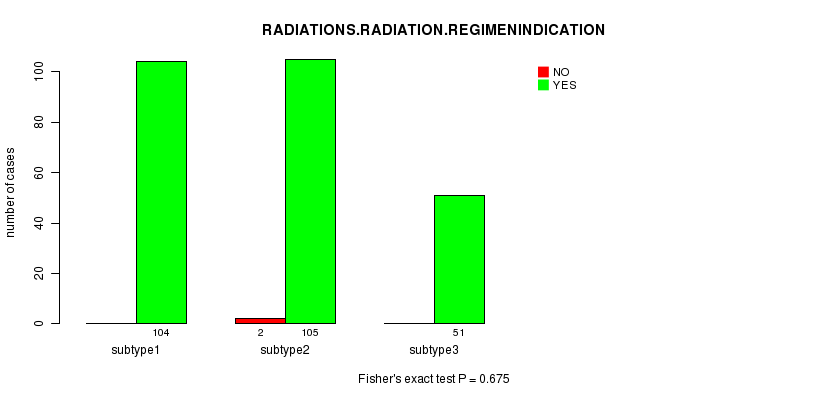
Table S71. Get Full Table Description of clustering approach #11: 'MIRseq CNMF subtypes'
| Cluster Labels | 1 | 2 | 3 |
|---|---|---|---|
| Number of samples | 113 | 195 | 146 |
P value = 0.0431 (logrank test)
Table S72. Clustering Approach #11: 'MIRseq CNMF subtypes' versus Clinical Feature #1: 'Time to Death'
| nPatients | nDeath | Duration Range (Median), Month | |
|---|---|---|---|
| ALL | 451 | 252 | 0.3 - 180.2 (30.1) |
| subtype1 | 113 | 74 | 0.3 - 152.0 (27.0) |
| subtype2 | 194 | 101 | 0.3 - 180.2 (32.5) |
| subtype3 | 144 | 77 | 0.3 - 130.0 (28.7) |
Figure S61. Get High-res Image Clustering Approach #11: 'MIRseq CNMF subtypes' versus Clinical Feature #1: 'Time to Death'
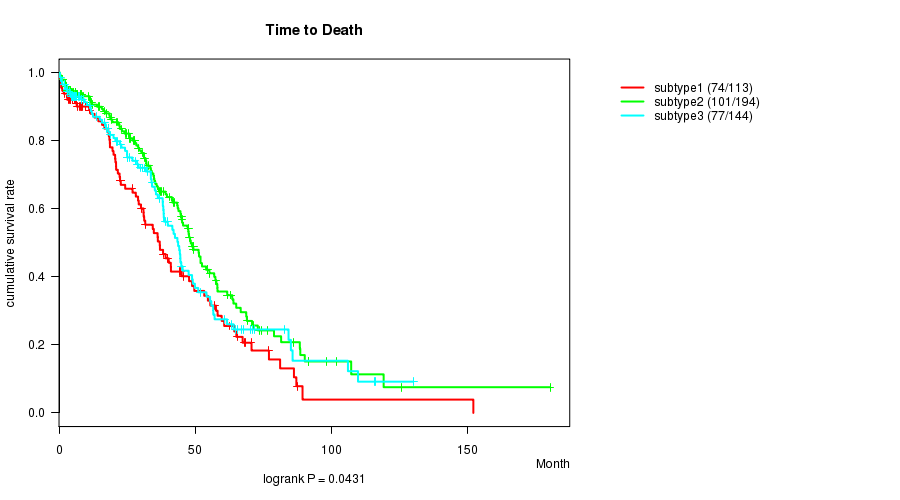
P value = 0.594 (ANOVA)
Table S73. Clustering Approach #11: 'MIRseq CNMF subtypes' versus Clinical Feature #2: 'AGE'
| nPatients | Mean (Std.Dev) | |
|---|---|---|
| ALL | 446 | 59.8 (11.5) |
| subtype1 | 112 | 60.8 (11.7) |
| subtype2 | 192 | 59.5 (11.3) |
| subtype3 | 142 | 59.5 (11.6) |
Figure S62. Get High-res Image Clustering Approach #11: 'MIRseq CNMF subtypes' versus Clinical Feature #2: 'AGE'
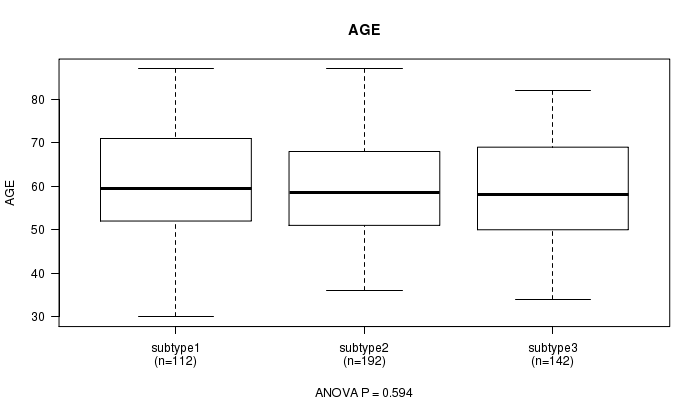
P value = 0.0583 (Chi-square test)
Table S74. Clustering Approach #11: 'MIRseq CNMF subtypes' versus Clinical Feature #3: 'PRIMARY.SITE.OF.DISEASE'
| nPatients | OMENTUM | OVARY | PERITONEUM (OVARY) |
|---|---|---|---|
| ALL | 2 | 451 | 1 |
| subtype1 | 2 | 110 | 1 |
| subtype2 | 0 | 195 | 0 |
| subtype3 | 0 | 146 | 0 |
Figure S63. Get High-res Image Clustering Approach #11: 'MIRseq CNMF subtypes' versus Clinical Feature #3: 'PRIMARY.SITE.OF.DISEASE'
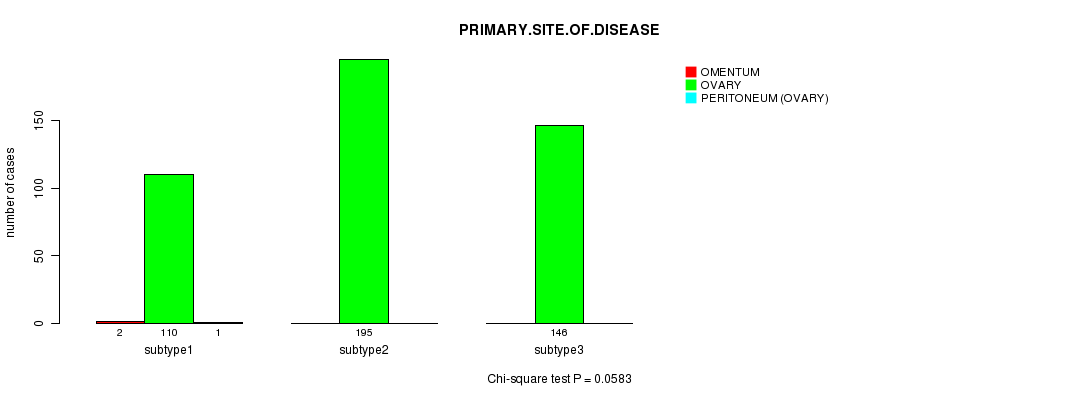
P value = 0.207 (ANOVA)
Table S75. Clustering Approach #11: 'MIRseq CNMF subtypes' versus Clinical Feature #4: 'KARNOFSKY.PERFORMANCE.SCORE'
| nPatients | Mean (Std.Dev) | |
|---|---|---|
| ALL | 64 | 75.3 (13.2) |
| subtype1 | 10 | 82.0 (14.8) |
| subtype2 | 46 | 74.3 (12.4) |
| subtype3 | 8 | 72.5 (14.9) |
Figure S64. Get High-res Image Clustering Approach #11: 'MIRseq CNMF subtypes' versus Clinical Feature #4: 'KARNOFSKY.PERFORMANCE.SCORE'
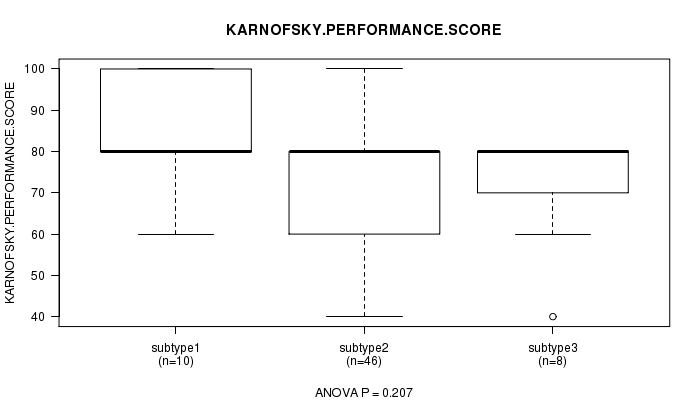
P value = 0.193 (Chi-square test)
Table S76. Clustering Approach #11: 'MIRseq CNMF subtypes' versus Clinical Feature #5: 'TUMOR.STAGE'
| nPatients | II | III | IV |
|---|---|---|---|
| ALL | 24 | 352 | 74 |
| subtype1 | 4 | 91 | 17 |
| subtype2 | 8 | 147 | 38 |
| subtype3 | 12 | 114 | 19 |
Figure S65. Get High-res Image Clustering Approach #11: 'MIRseq CNMF subtypes' versus Clinical Feature #5: 'TUMOR.STAGE'
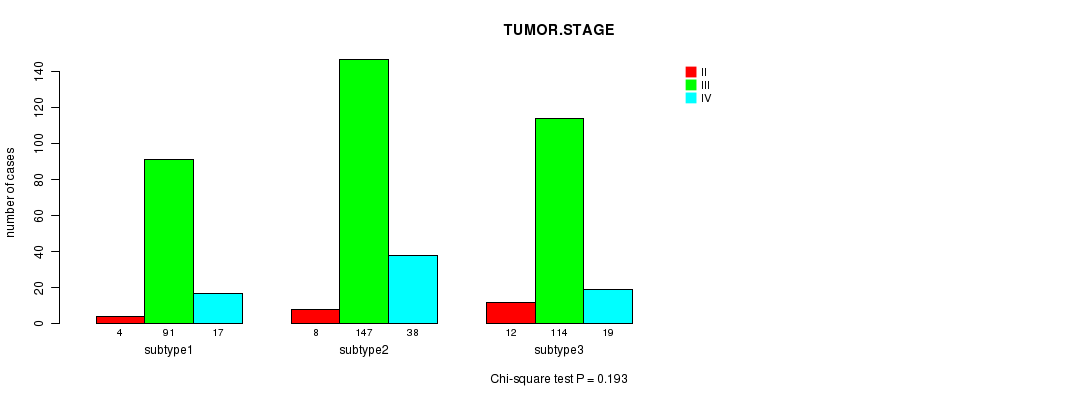
P value = 0.476 (Fisher's exact test)
Table S77. Clustering Approach #11: 'MIRseq CNMF subtypes' versus Clinical Feature #6: 'RADIATIONS.RADIATION.REGIMENINDICATION'
| nPatients | NO | YES |
|---|---|---|
| ALL | 3 | 451 |
| subtype1 | 0 | 113 |
| subtype2 | 1 | 194 |
| subtype3 | 2 | 144 |
Figure S66. Get High-res Image Clustering Approach #11: 'MIRseq CNMF subtypes' versus Clinical Feature #6: 'RADIATIONS.RADIATION.REGIMENINDICATION'
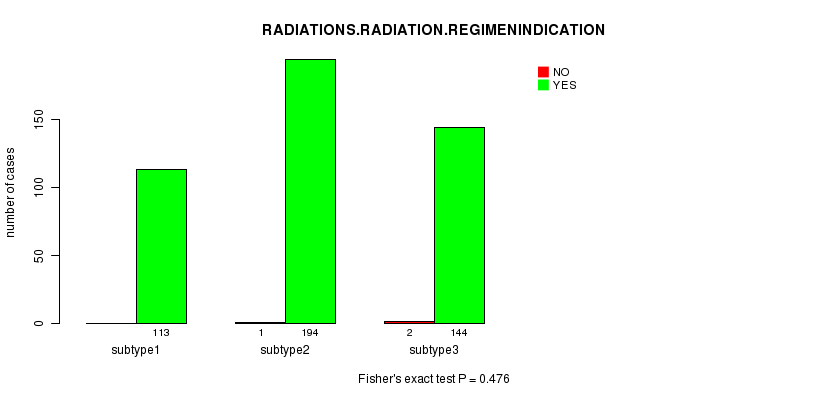
Table S78. Get Full Table Description of clustering approach #12: 'MIRseq cHierClus subtypes'
| Cluster Labels | 1 | 2 | 3 |
|---|---|---|---|
| Number of samples | 3 | 153 | 298 |
P value = 0.563 (logrank test)
Table S79. Clustering Approach #12: 'MIRseq cHierClus subtypes' versus Clinical Feature #1: 'Time to Death'
| nPatients | nDeath | Duration Range (Median), Month | |
|---|---|---|---|
| ALL | 451 | 252 | 0.3 - 180.2 (30.1) |
| subtype1 | 3 | 3 | 4.5 - 60.6 (33.7) |
| subtype2 | 151 | 82 | 0.3 - 130.0 (28.6) |
| subtype3 | 297 | 167 | 0.3 - 180.2 (31.0) |
Figure S67. Get High-res Image Clustering Approach #12: 'MIRseq cHierClus subtypes' versus Clinical Feature #1: 'Time to Death'
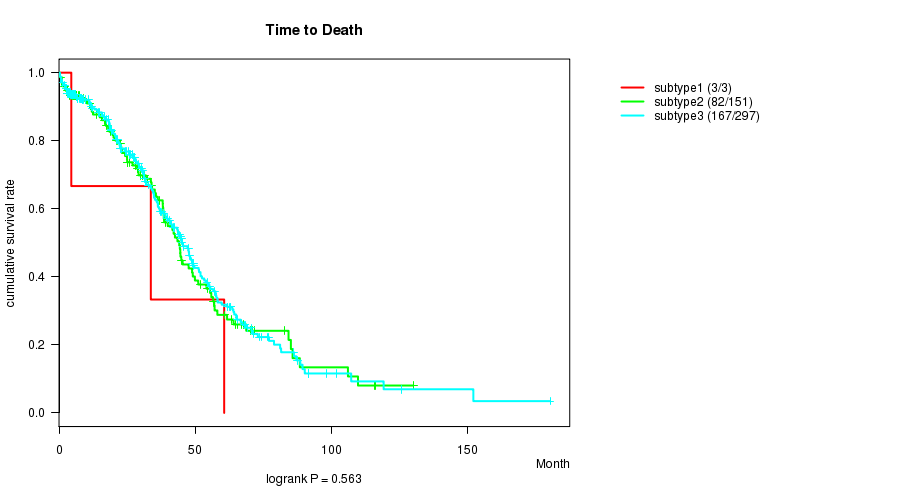
P value = 0.757 (ANOVA)
Table S80. Clustering Approach #12: 'MIRseq cHierClus subtypes' versus Clinical Feature #2: 'AGE'
| nPatients | Mean (Std.Dev) | |
|---|---|---|
| ALL | 446 | 59.8 (11.5) |
| subtype1 | 3 | 62.7 (1.5) |
| subtype2 | 149 | 59.3 (11.9) |
| subtype3 | 294 | 60.0 (11.4) |
Figure S68. Get High-res Image Clustering Approach #12: 'MIRseq cHierClus subtypes' versus Clinical Feature #2: 'AGE'
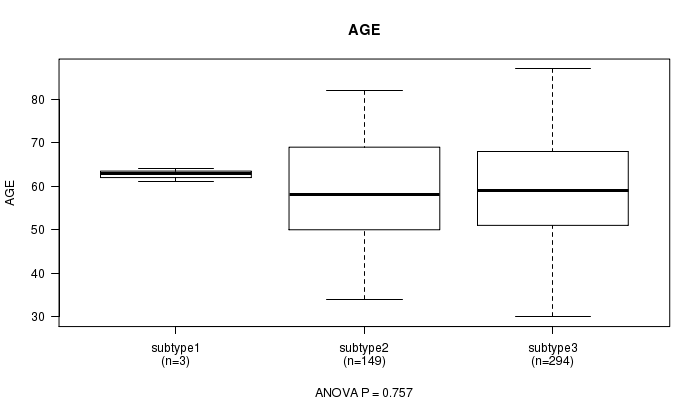
P value = 0.812 (Chi-square test)
Table S81. Clustering Approach #12: 'MIRseq cHierClus subtypes' versus Clinical Feature #3: 'PRIMARY.SITE.OF.DISEASE'
| nPatients | OMENTUM | OVARY | PERITONEUM (OVARY) |
|---|---|---|---|
| ALL | 2 | 451 | 1 |
| subtype1 | 0 | 3 | 0 |
| subtype2 | 0 | 153 | 0 |
| subtype3 | 2 | 295 | 1 |
Figure S69. Get High-res Image Clustering Approach #12: 'MIRseq cHierClus subtypes' versus Clinical Feature #3: 'PRIMARY.SITE.OF.DISEASE'
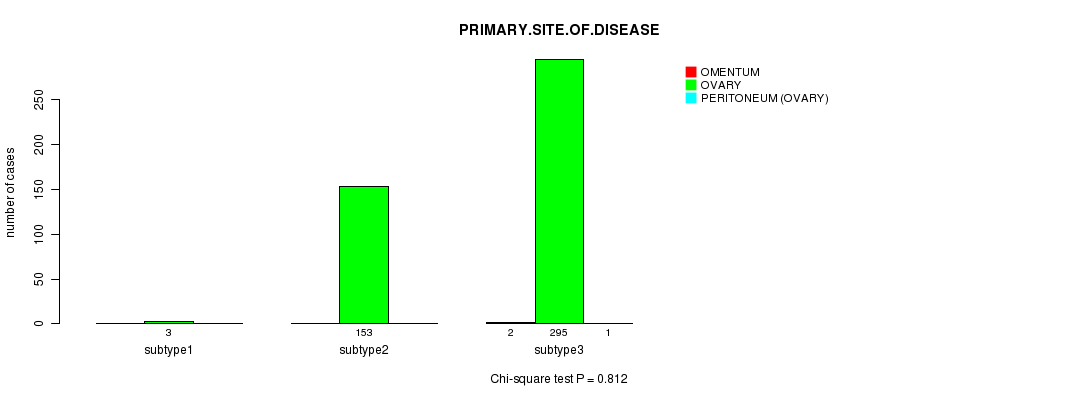
P value = 0.577 (ANOVA)
Table S82. Clustering Approach #12: 'MIRseq cHierClus subtypes' versus Clinical Feature #4: 'KARNOFSKY.PERFORMANCE.SCORE'
| nPatients | Mean (Std.Dev) | |
|---|---|---|
| ALL | 64 | 75.3 (13.2) |
| subtype2 | 8 | 72.5 (14.9) |
| subtype3 | 56 | 75.7 (13.1) |
Figure S70. Get High-res Image Clustering Approach #12: 'MIRseq cHierClus subtypes' versus Clinical Feature #4: 'KARNOFSKY.PERFORMANCE.SCORE'
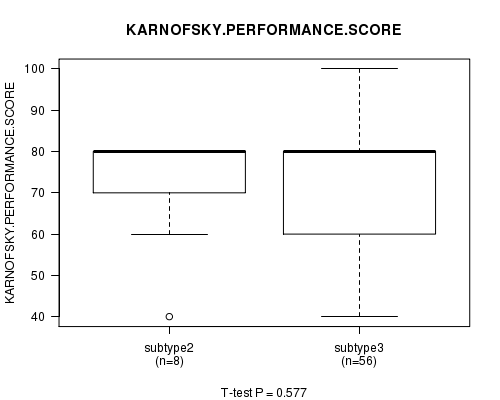
P value = 0.49 (Chi-square test)
Table S83. Clustering Approach #12: 'MIRseq cHierClus subtypes' versus Clinical Feature #5: 'TUMOR.STAGE'
| nPatients | II | III | IV |
|---|---|---|---|
| ALL | 24 | 352 | 74 |
| subtype1 | 0 | 3 | 0 |
| subtype2 | 11 | 120 | 21 |
| subtype3 | 13 | 229 | 53 |
Figure S71. Get High-res Image Clustering Approach #12: 'MIRseq cHierClus subtypes' versus Clinical Feature #5: 'TUMOR.STAGE'
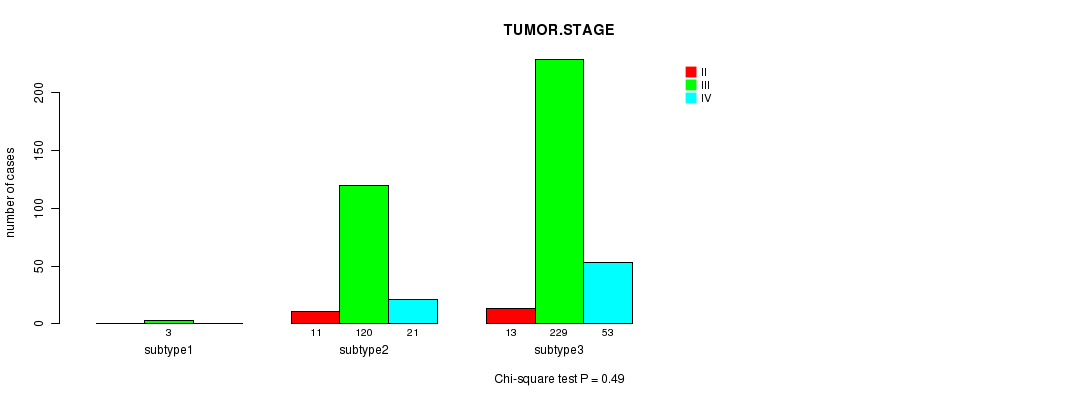
P value = 0.281 (Fisher's exact test)
Table S84. Clustering Approach #12: 'MIRseq cHierClus subtypes' versus Clinical Feature #6: 'RADIATIONS.RADIATION.REGIMENINDICATION'
| nPatients | NO | YES |
|---|---|---|
| ALL | 3 | 451 |
| subtype1 | 0 | 3 |
| subtype2 | 2 | 151 |
| subtype3 | 1 | 297 |
Figure S72. Get High-res Image Clustering Approach #12: 'MIRseq cHierClus subtypes' versus Clinical Feature #6: 'RADIATIONS.RADIATION.REGIMENINDICATION'
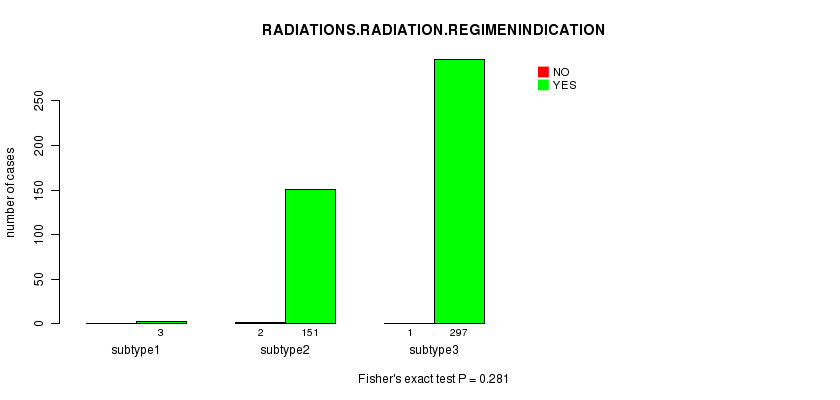
-
Cluster data file = OV-TP.mergedcluster.txt
-
Clinical data file = OV-TP.clin.merged.picked.txt
-
Number of patients = 578
-
Number of clustering approaches = 12
-
Number of selected clinical features = 6
-
Exclude small clusters that include fewer than K patients, K = 3
consensus non-negative matrix factorization clustering approach (Brunet et al. 2004)
Resampling-based clustering method (Monti et al. 2003)
For survival clinical features, the Kaplan-Meier survival curves of tumors with and without gene mutations were plotted and the statistical significance P values were estimated by logrank test (Bland and Altman 2004) using the 'survdiff' function in R
For continuous numerical clinical features, one-way analysis of variance (Howell 2002) was applied to compare the clinical values between tumor subtypes using 'anova' function in R
For multi-class clinical features (nominal or ordinal), Chi-square tests (Greenwood and Nikulin 1996) were used to estimate the P values using the 'chisq.test' function in R
For binary clinical features, two-tailed Fisher's exact tests (Fisher 1922) were used to estimate the P values using the 'fisher.test' function in R
This is an experimental feature. The full results of the analysis summarized in this report can be downloaded from the TCGA Data Coordination Center.